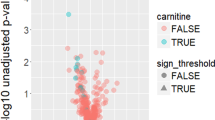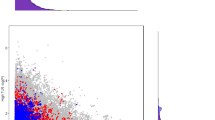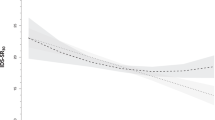Abstract
Major depression and the metabolic syndrome (MetS) are interacting clinical conditions influenced by genetic susceptibility. For both disorders, impaired serotonergic neurotransmission in specific brain areas has been suggested. This led us to investigate whether variants in the gene coding for tryptophan hydroxylase 2 (TPH2), the brain-specific and rate-limiting enzyme for serotonin biosynthesis, might be predictive for an increased liability for the development of MetS in depressed patients. In a case–control study consisting of 988 patients with recurrent unipolar depression (RUD) and 1023 psychiatric healthy controls, MetS components were ascertained according to the International Diabetes Foundation criteria. A total of 41 single nucleotide polymorphisms fully covering the TPH2 gene region were genotyped in stage 1 (300 patients/300 controls), resulting in significant genetic associations of polymorphisms located in exon 7 and intron 8 of TPH2 and the occurrence of MetS in depressed patients after correction for age, gender and multiple testing (51 RUD-MetS/179 RUD-non-MetS). We were able to confirm the significant association of rs17110690 in stage 2 (688 patients/723 controls; 110 RUD-MetS/549 RUD-non-MetS) and to link risk-genotypes and risk-haplotypes for MetS to lower TPH2 mRNA expression and to lower 5-hydroxyindoleacetic acid levels in cerebrospinal fluid previously reported in functional studies. Our findings suggest that TPH2 polymorphisms characterize a subgroup of depressed patients who are especially prone to develop metabolic disorders induced by a genotype-dependent impairment of serotonergic neurotransmission. Identifying depressed patients at high risk for MetS using genetic variants could have direct clinical impact on individualized disease management and prevention strategies.
This is a preview of subscription content, access via your institution
Access options
Subscribe to this journal
Receive 12 print issues and online access
$259.00 per year
only $21.58 per issue
Buy this article
- Purchase on Springer Link
- Instant access to full article PDF
Prices may be subject to local taxes which are calculated during checkout


Similar content being viewed by others
References
Park Y-W, Zhu S, Palaniappan L, Heshka S, Carnethon MR, Heymsfield SB . The metabolic syndrome: prevalence and associated risk factor findings in the US population from the Third National Health and Nutrition Examination Survey, 1988–1994. Arch Intern Med 2003; 163: 427–436.
Steinbaum SR . The metabolic syndrome: an emerging health epidemic in women. Prog Cardiovasc Dis 2004; 46: 321.
Ford ES, Giles WH, Dietz WH . Prevalence of the metabolic syndrome among US Adults: Findings From the Third National Health and Nutrition Examination Survey. JAMA 2002; 287: 356–359.
Kessler RC, McGonagle KA, Zhao S, Nelson CB, Hughes M, Eshleman S et al. Lifetime and 12-month prevalence of DSM-III-R psychiatric disorders in the United States. Results from the National Comorbidity Survey. Arch Gen Psychiatry 1994; 51: 8–19.
Stover E, Fenton W, Rosenfeld A, Insel TR . Depression and comorbid medical illness: the National Institute of Mental Health perspective. Biol Psychiatry 2003; 54: 184.
Eckel RH, Grundy SM, Zimmet PZ . The metabolic syndrome. Lancet 2005; 365: 1415.
Sacks FM . Metabolic syndrome: epidemiology and consequences. J Clin Psychiatry 2004; 65: 3–12.
Musselman DL, Evans DL, Nemeroff CB . The relationship of depression to cardiovascular disease: epidemiology, biology, and treatment. Arch Gen Psychiatry 1998; 55: 580–592.
Scherrer JF, Xian H, Bucholz KK, Eisen SA, Lyons MJ, Goldberg J et al. A twin study of depression symptoms, hypertension, and heart disease in middle-aged men. Psychosom Med 2003; 65: 548–557.
Kinder LS, Carnethon MR, Palaniappan LP, King AC, Fortmann SP . Depression and the metabolic syndrome in young adults: findings from the Third National Health and Nutrition Examination Survey. Psychosom Med 2004; 66: 316–322.
Raikkonen K, Matthews KA, Kuller LH . The relationship between psychological risk attributes and the metabolic syndrome in healthy women: antecedent or consequence? Metabolism 2002; 51: 1573–1577.
Skilton MR, Moulin P, Terra J-L, Bonnet F . Associations between anxiety, depression, and the metabolic syndrome. Biol Psychiatry 62: 1251–1257.
Timonen M, Laakso M, Jokelainen J, Rajala U, Meyer-Rochow VB, Keinanen-Kiukaanniemi S . Insulin resistance and depression: cross sectional study. BMJ 2005; 330: 17–18.
Hasler G, Lissek S, Ajdacic V, Milos G, Gamma A, Eich D et al. Major depression predicts an increase in long-term body weight variability in young adults. Obes Res 2005; 13: 1991–1998.
Toker S, Shirom A, Melamed S . Depression and the metabolic syndrome: gender-dependent associations. Depress Anxiety 2008; 25: 661–669.
Hu FB, Stampfer M, Manson JE . Physical activity and cardiovascular risk in diabetic women—response. Ann Intern Med 2001; 135: 931.
Chen W, Srinivasan SR, Elkasabany A, Berenson GS . The association of cardiovascular risk factor clustering related to insulin resistance syndrome (Syndrome X) between young parents and their offspring: the Bogalusa Heart Study. Atherosclerosis 1999; 145: 197–205.
Carmelli D, Cardon LR, Fabsitz R . Clustering of hypertension, diabetes, and obesity in adult male twins—same genes or same environments. Am J Hum Genet 1994; 55: 566–573.
Phillips C, Lopez-Miranda J, Perez-Jimenez F, McManus R, Roche HM . Genetic and nutrient determinants of the metabolic syndrome. Curr Opin Cardiol 2006; 21: 185–193.
Pollex RL, Hegele RA . Genetic determinants of the metabolic syndrome. Nat Clin Prac Cardiovasc Med 2006; 3: 482–489.
McGuffin P, Katz R, Watkins S, Rutherford J . A hospital-based twin register of the heritability of DSM-IV unipolar depression. Arch Gen Psychiatry 1996; 53: 129–136.
Sullivan PF, Neale MC, Kendler KS . Genetic epidemiology of major depression: review and meta-analysis. Am J Psychiatry 2000; 157: 1552–1562.
Hamet P, Tremblay J . Genetics and genomics of depression. Metabolism 2005; 54 (5 Suppl 1): 10.
Levinson DF . The genetics of depression: a review. Biol Psychiatry 2006; 60: 84–92.
Wurtman RJ, Wurtman JJ . Serotoninergic mechanisms and obesity. J Nutr Biochem 1998; 9: 511–515.
Muldoon MF, Mackey RH, Korytkowski MT, Flory JD, Pollock BG, Manuck SB . The metabolic syndrome is associated with reduced central serotonergic responsivity in healthy community volunteers. J Clin Endocrinol Metab 2006; 91: 718–721.
Rosmond R . Obesity and depression: same disease, different names? Med Hypotheses 2004; 62: 976–979.
Muldoon MF, Mackey RH, Williams KV, Korytkowski MT, Flory JD, Manuck SB . Low central nervous system serotonergic responsivity is associated with the metabolic syndrome and physical inactivity. J Clin Endocrinol Metab 2004; 89: 266–271.
Meltzer H . Serotonergic dysfunction in depression. Br J Psychiatry 1989; 155: 25–31.
Placidi GPA, Oquendo MA, Malone KM, Huang YY, Ellis SP, Mann JJ . Aggressivity, suicide attempts, and depression: relationship to cerebrospinal fluid monoamine metabolite levels. Biol Psychiatry 2001; 50: 783–791.
Williams Jr JW, Mulrow CD, Chiquette E, Noel PH, Aguilar C, Cornell J . A systematic review of newer pharmacotherapies for depression in adults: evidence report summary: clinical guideline, part 2. Ann Intern Med 2000; 132: 743–756.
Aronne LJ . Therapeutic options for modifying cardiometabolic risk factors. Am J Med 2007; 120 (3 Suppl 1): S26.
Padwal RS, Majumdar SR . Drug treatments for obesity: orlistat, sibutramine, and rimonabant. Lancet 2007; 369: 71–77.
Von Ruden AE, Adson DE, Kotlyar M . Effect of selective serotonin reuptake inhibitors on cardiovascular morbidity and mortality. J Cardiovasc Pharmacol Ther 2008; 13: 32–40.
Zhang X, Beaulieu J-M, Sotnikova TD, Gainetdinov RR, Caron MG . Tryptophan hydroxylase-2 controls brain serotonin synthesis. Science 2004; 305: 217.
Zill P, Buttner A, Eisenmenger W, Moller H-J, Ackenheil M, Bondy B . Analysis of tryptophan hydroxylase I and II mRNA expression in the human brain: a post-mortem study. J Psychiatr Res 2007; 41 (1–2): 168.
Paresh DP, Crystal P, Sharon B . Robust and tissue-specific expression of TPH2 versus TPH1 in rat raphe and pineal gland. Biol Psychiatry 2004; 55: 428.
Lin Y-MJ, Chao S-C, Chen T-M, Lai T-J, Chen J-S, Sun HS . Association of functional polymorphisms of the human tryptophan hydroxylase 2 gene with risk for bipolar disorder in Han Chinese. Arch Gen Psychiatry 2007; 64: 1015–1024.
Lopez VA, Detera-Wadleigh S, Cardona I, Kassem L, McMahon FJ . Nested association between genetic variation in tryptophan hydroxylase II, bipolar affective disorder, and suicide attempts. Biol Psychiatry 2007; 61: 181–186.
Van Den Bogaert A, Sleegers K, De Zutter S, Heyrman L, Norrback KF, Adolfsson R et al. Association of brain-specific tryptophan hydroxylase, TPH2, with unipolar and bipolar disorder in a Northern Swedish, isolated population. Arch Gen Psychiatry 2006; 63: 1103–1110.
Zhang X, Gainetdinov RR, Beaulieu JM, Sotnikova TD, Burch LH, Williams RB et al. Loss-of-function mutation in tryptophan hydroxylase-2 identified in unipolar major depression. Neuron 2005; 45: 11.
Zhou Z, Roy A, Lipsky R, Kuchipudi K, Zhu G, Taubman J et al. Haplotype-based linkage of tryptophan hydroxylase 2 to suicide attempt, major depression, and cerebrospinal fluid 5-hydroxyindoleacetic acid in 4 populations. Arch Gen Psychiatry 2005; 62: 1109–1118.
Zill P, Buttner A, Eisenmenger W, Moller H-J, Bondy B, Ackenheil M . Single nucleotide polymorphism and haplotype analysis of a novel tryptophan hydroxylase isoform (TPH2) gene in suicide victims. Biol Psychiatry 2004; 56: 581.
Cichon S, Winge I, Mattheisen M, Georgi A, Karpushova A, Freudenberg J et al. Brain-specific tryptophan hydroxylase 2 (TPH2): a functional Pro206Ser substitution and variation in the 5′-region are associated with bipolar affective disorder. Hum Mol Genet 2008; 17: 87–97.
Harvey M, Gagne B, Labbe M, Barden N . Polymorphisms in the neuronal isoform of tryptophan hydroxylase 2 are associated with bipolar disorder in French Canadian pedigrees. Psychiatr Genet 2007; 17: 17–22.
Kloiber S, Ising M, Reppermund S, Horstmann S, Dose T, Majer M et al. Overweight and obesity affect treatment response in major depression. Biol Psychiatry 2007; 62: 321.
Lucae S, Salyakina D, Barden N, Harvey M, Gagné B, Labbé M et al. P2RX7, a gene coding for a purinergic ligand-gated ion channel, is associated with major depressive disorder. Hum Mol Genet 2006; 15: 2438–2445.
Celik C . Computer Assisted Personal Interviewing Application for the Schedules for the Clinical Assessment in Neuropsychiatry Version 2.1 and Diagnostic Algorithms for WHO ICD10 chapter V DCR and for Statistical Manual IV./Release 1 Ed. 1.0.3.5 Win9xNT. World Health Organization: Geneva, 2003.
Wittchen HU, Höfler M, Gander F . Screening for mental disorders: performance of the Composite International Diagnostic—Screener (CID-S). Methods Psychiatr Res 1999; 8: 59–79.
Alberti KGMM, Zimmet P, Shaw J . The metabolic syndrome—a new worldwide definition. Lancet 2005; 366: 1059.
Pruitt KD, Tatusova T, Maglott DR . NCBI Reference Sequence (RefSeq): a curated non-redundant sequence database of genomes, transcripts and proteins. Nucleic Acids Res 2005; 33: D501–D504.
Tang K, Fu D-J, Julien D, Braun A, Cantor CR, Koster H . Chip-based genotyping by mass spectrometry. Proc Natl Acad Sci USA 1999; 96: 10016–10020.
Hill WG, Robertson A . Linkage disequilibrium in finite populations. Theor Appl Genet 1968; 38: 226.
Barrett JC, Fry B, Maller J, Daly MJ . Haploview: analysis and visualization of LD and haplotype maps. Bioinformatics 2005; 21: 263–265.
Gabriel SB, Schaffner SF, Nguyen H, Moore JM, Roy J, Blumenstiel B et al. The structure of haplotype blocks in the human genome. Science 2002; 296: 2225–2229.
Purcell S, Cherny SS, Sham PC . Genetic power calculator: design of linkage and association genetic mapping studies of complex traits. Bioinformatics 2003; 19: 149–150.
Wigginton JE, Cutler DJ, Abecasis GR . A note on exact tests of Hardy–Weinberg equilibrium. Am J Hum Genet 2005; 76: 887–893.
Chiano MN, Clayton DG . Genotypic relative risks under ordered restriction. Genet Epidemiol 1998; 15: 135–146.
Westfall PH, Stanley Y . Resampling-based Multiple Testing. Wiley: New York, 1993.
Chen GL, Novak MA, Hakim S, Xie Z, Miller GM . Tryptophan hydroxylase-2 gene polymorphisms in rhesus monkeys: association with hypothalamic-pituitary-adrenal axis function and in vitro gene expression. Mol Psychiatry 2006; 11: 914.
Lim JE, Pinsonneault J, Sadee W, Saffen D . Tryptophan hydroxylase 2 (TPH2) haplotypes predict levels of TPH2 mRNA expression in human pons. Mol Psychiatry 2006; 12: 491.
Lucki I . The spectrum of behaviors influenced by serotonin. Biol Psychiatry 1998; 44: 151–162.
Mann JJ, Arango V, Underwood MD . Serotonin and suicidal-behavior. Ann NY Acad Sci 1990; 600: 476–485.
Hainer V, Kabrnova K, Aldhoon B, Kunesova M, Wagenknecht M . Serotonin and norepinephrine reuptake inhibition and eating behavior. Ann NY Acad Sci 2006; 1083: 252–269.
Peñalva RG, Flachskamm C, Zimmermann S, Wurst W, Holsboer F, Reul JM et al. Corticotropin-releasing hormone receptor type 1-deficiency enhances hippocampal serotonergic neurotransmission: an in vivo microdialysis study in mutant mice. Neuroscience 2002; 109: 253.
Clark JA, Flick RB, Pai LY, Szalayova I, Key S, Conley RK et al. Glucocorticoid modulation of tryptophan hydroxylase-2 protein in raphe nuclei and 5-hydroxytryptophan concentrations in frontal cortex of C57//Bl6 mice. Mol Psychiatry 2008; 13: 498–506.
Malek ZS, Sage D, Pevet P, Raison S . Daily rhythm of tryptophan hydroxylase-2 mRNA within raphe neurons is induced by corticoid daily surge and modulated by enhanced locomotor activity. Endocrinology 2007; 148: 5165–5172: en: 2007–0526.
Molnar D . The prevalence of the metabolic syndrome and type 2 diabetes mellitus in children and adolescents. Int J Obes Relat Metab Disord 2004; 28 (S3): S70.
Herva A, Rasanen P, Miettunen J, Timonen M, Läksy K, Veijola J et al. Co-occurrence of metabolic syndrome with depression and anxiety in young adults: the Northern Finland 1966 Birth Cohort Study. Psychosom Med 2006; 68: 213–216.
Zimmermann U, Kraus T, Himmerich H, Schuld A, Pollmacher T . Epidemiology, implications and mechanisms underlying drug-induced weight gain in psychiatric patients. J Psychiatr Res 2003; 37: 193–220.
Holsboer F . How can we realize the promise of personalized antidepressant medicines? Nat Rev Neurosci 2008; 9: 638.
Acknowledgements
We thank S Damast, S Sauer, G Ernst-Jansen, G Gajewsky and J Huber for their excellent technical assistance. This work was funded by the Max-Planck Society and the Federal Ministry of Education and Research (BMBF) in the framework of the National Genome Research Network (NGFN), Förderkennzeichen 01GS0481. The authors are responsible for the contents of this publication.
Author information
Authors and Affiliations
Corresponding author
Additional information
Parts of the data have been presented in a poster presentation at the World Congress on Psychiatric Genetics, October 2007, New York, NY, USA and the Second Meeting of West European Societies of Biological Psychiatry, December 2007, Strasbourg, France.
Rights and permissions
About this article
Cite this article
Kloiber, S., Kohli, M., Brueckl, T. et al. Variations in tryptophan hydroxylase 2 linked to decreased serotonergic activity are associated with elevated risk for metabolic syndrome in depression. Mol Psychiatry 15, 736–747 (2010). https://doi.org/10.1038/mp.2008.142
Received:
Revised:
Accepted:
Published:
Issue Date:
DOI: https://doi.org/10.1038/mp.2008.142
Keywords
This article is cited by
-
The Comorbidity between Depression and Diabetes
Current Psychiatry Reports (2013)



